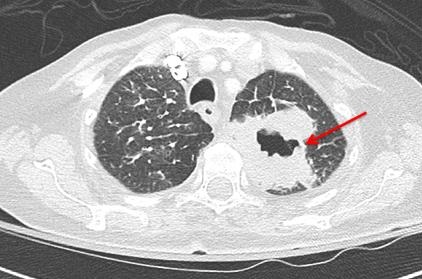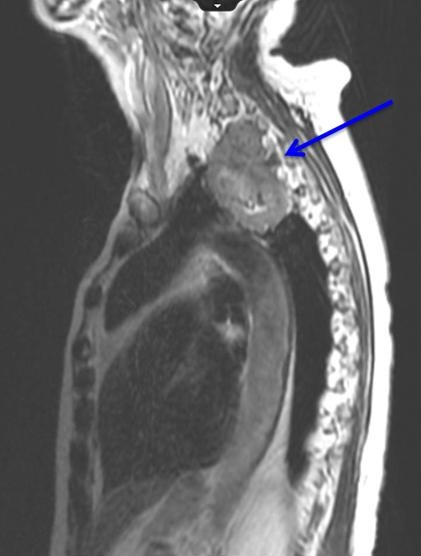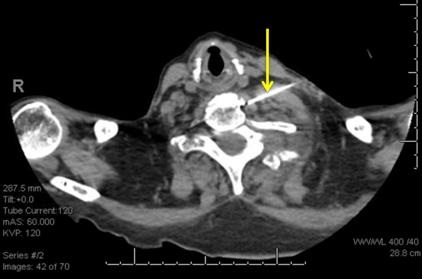Medical Image of the Week: Zenker’s Diverticulum
 Wednesday, July 5, 2017 at 8:00AM
Wednesday, July 5, 2017 at 8:00AM 
Figure 1. Panel A: PA view chest x-ray shows possible cavitation with air-fluid level in the right upper lobe (arrow). Panel B: lateral view chest x-ray shows possible cavitation with air-fluid level in the right upper lobe (arrow).

Figure 2. Coronal section of the thoracic CT scan shows focal dilation of the upper thoracic esophagus which contains fluid (arrow).

Figure 3. Endoscopic view of the upper esophagus showing the diverticulum with impacted food bolus.
A 71-year-old man with history of recurrent aspiration pneumonia and previous esophageal surgery presented to the Emergency Department with acute hypoxia and leukocytosis. Imaging, above, showed a consolidation in the RUL and on lateral view an air fluid level. This was suspicious for infection or malignancy. For the ongoing concern for possible esophageal pathology given previous surgery, GI was consulted and upper endoscopy performed. He was found to have an esophageal dilation at repair site of a previous Zenker’s diverticulum filled with food.
Zenker’s Diverticulum is a defect in the muscular wall of the hypopharynx in an area known as Killian's triangle. This condition is male predominant mainly occurring in the 3rd to 4th decade and/or the 7th to 8th decade of life. The out pouching created will accumulate food and eventually lead to high incidences of aspiration pneumonia. Treatment is usually surgical in nature and can cause vocal cord damage and even recurrence of the outpouching (1).
Chandra Stockdall MD and Roberto Swazo MD
Department of Internal Medicine
Banner University Medical Center South Campus
Tucson, AZ USA
Reference
- Mulder C, Van Delft F. Zenker’s diverticulum. UpToDate. May, 2017. Available at: http://www.uptodate.com/contents/zenkers-diverticulum (requires subscription, accessed 6/30/17).
Cite as: Stockdall C, Swazo R. Medical image of the week: Zenker's diverticulum. Southwest J Pulm Crit Care. 2017;15(1):15-6. doi: https://doi.org/10.13175/swjpcc075-17 PDF



